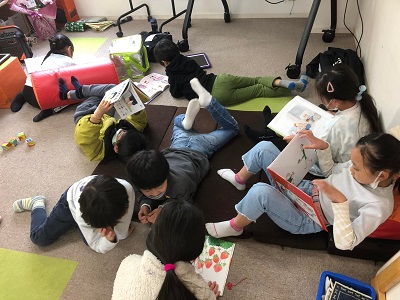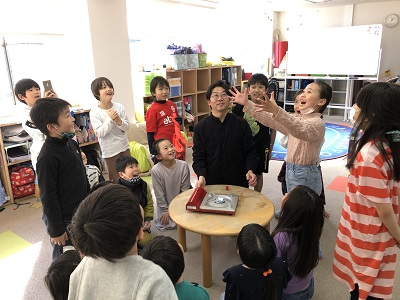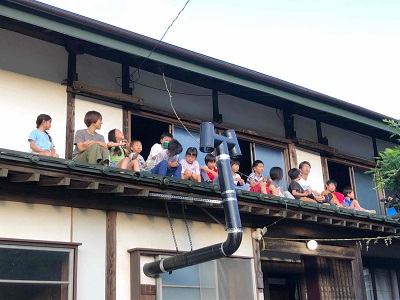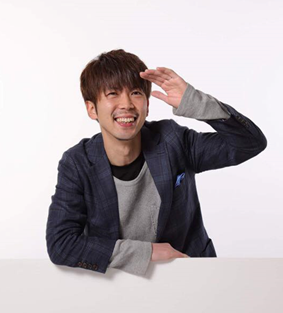Having established an alternative school, I currently spend time creating an environment for learning with children every day. I am often asked the reason for having left a stable job after 14 years as a public elementary school teacher. The main reason is that I wished to make a place for inclusive learning with my own hands and see it with my own eyes. Today I would like to discuss the days of trial and error before finally reaching this goal.
During the four years at Koganei Municipal Elementary School, which was the last public school I taught at, every day was a challenging attempt to see the extent to which inclusive education could be achieved in public elementary schools. For me, the standard for inclusivity would be a class where "that child I met at a special needs school would be able to study with others in the class." A class where such a child could study was also expected to be a good environment where other children could comfortably study. With this point of view in mind, I have worked to rebuild and renew what has been thought of as "ordinary."
Today, in most public education classes, lessons are given collectively in a uniform style. Everyone is given assignments at the same level to work on at the same pace and in the same way and then assessed according to a single evaluation standard to determine outstanding or poor performance. Such an environment is hardly a comfortable place for learning to many children, let alone "that child" I had met in special needs school. That is why we came to implement "self-paced learning."
Self-paced learning primarily began in Math class. We made a drastic decision to summarize the 45-minute lesson into 10 minutes, and gave the students work in accordance with their level so that they could undertake it at their own pace and in their own way in the 25 minutes prior to the last 10-minute wrap-up. This did not go well at first. At times, we were given harsh opinions from parents and peers and nearly gave up using this method. Nevertheless, we kept this going because students responded by studying with energy and motivation when we assured them with a degree of freedom.
About three years after starting this challenging project, the entire school was able to securely offer self-paced learning for all grades. In the fifth grade class at the time, next to a student dealing with second-grade multiplication, there would be another student making an all-out effort in 12th-grade level mathematics. No comparisons were made, but rather respect and joy were expressed for each other for having done their best and achieved such growth. Having seen and experienced this, it was clear "that student" would be able to stay in the class and I can't forget the joy I felt at the time.

In science and society, I intentionally introduced inquisitive learning in my class. Take, for example, the teaching unit of "the universe" in science, I would first give central focus to the contents of the textbook. Then the students were encouraged to follow up by pursuing their own interests such as the origin of the universe or black holes and looking up information in other resources. Even students who did not appear to be scholastically inclined would find it fun to follow and study their own interests. In this way, all children, even "that child I met at special needs school," can have fun following his personal interest.

There were, however, things that stood in the way and some obstacles could not be overcome. The most serious was evaluation. Although the school has discretion in the style of report cards, it is not easy to abolish conventional methods of evaluation since it involves parental opinions and decisions made by the school as well as the relation to nearby elementary/junior high schools. Numerical evaluation means that one method must be used as a fixed standard of evaluation in all cases and a standardized test must be adopted. By doing so, the enjoyment of learning which was just returning, and feelings of restored self-confidence would then be drenched in cold water. When the expected evaluation is not received, parents worry and they may take it out on children and schools. As for me, I felt that was not our intentions. What a waste!
If we have to make an evaluation, there is no choice but to ensure that the designated level of learning is being absorbed or established in each child of the particular grade. For example, some students may not yet understand how to calculate the area of a square, but when they enter the sixth grade, they must all learn how to calculate the area of a circle. Furthermore, according to the law, textbooks must be used so it is not possible to reject the use of the textbook because it does not suit the student's ability. From another legal point of view, just as class time for mathematics is set at a fixed number annually, standard annual lesson hours are determined by the law. Even if a student says that he or she is not good at the kanji (Chinese characters) and wants to practice more, it is not permissible to let him/her practice during another subject such as mathematics.
In any case, public schools are somewhat busy. There is not enough time to thoroughly look up and study what one likes, to seek and hold heated discussions to solve problems when trouble occurs or to spend time aiming to make a better class through trial and error. If a class does not reach the expected end after the one-year period, it becomes a very serious matter. Adults tend to set up systems prioritizing efficiency and avoiding trouble. But is that really for the good of the children? Does it really lead to acquiring the essence of learning and real strength?
In order to create the ideal place that I envisioned, rather than attempting it at public schools which would involve much sacrifice and hardship, I wanted to do what I believed to be essential under my responsibility, so I decided to become independent. Currently, many associates, parents with the same views, and children have gathered at the Hillock Primary School, where I am now the principal.
This learning does not involve grades, competition or the burden of having to continue studying until a certain level is reached. This is simply a school where the fun of learning can be freely pursued. There are students who once refused to attend school, children who attended special needs classes, gifted children, children who have found life hard, and those who have no problem attending school.Diverse groups of children are now freely studying together with mutual respect in places that are no longer even limited to a certain number of students in the same grade. One year has passed since the opening of the school in April 2022, and under the slogan "Cultivate the strength to be happy," the children are resiliently leading a stress-free life. Seeing them exceeds my expectations and there is much that adults can learn.
Inclusive learning spaces are not dreams. By witnessing the growth of Hillock Primary School, this confidence became a certainty. I would like more people to witness this. Let us show to others what we are learning from children, and discuss what the ideal environment for learning is.
















